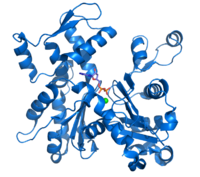
Photo from wikipedia
Cytoskeleton systems, actin microfilaments, microtubules (MTs) and intermediate filaments (IFs) provide the biomechanical stability and spatial organization in cells. To understand the specific contributions of each cytoskeleton systems to intrinsic… Click to show full abstract
Cytoskeleton systems, actin microfilaments, microtubules (MTs) and intermediate filaments (IFs) provide the biomechanical stability and spatial organization in cells. To understand the specific contributions of each cytoskeleton systems to intrinsic properties of spheroids, we've scrutinized the effects of the cytoskeleton perturbants, cytochalasin D (Cyto D), nocodazole (Noc) and withaferin A (WFA) on fusion, spreading on adhesive surface, morphology and biomechanics of chondrospheres (CSs). We confirmed that treatment with Cyto D but not with Noc or WFA severely affected CSs fusion and spreading dynamics and significantly reduced biomechanical properties of cell aggregates. Noc treatment affected spheroids spreading but not the fusion and surprisingly enhanced their stiffness biomechanical properties. Vimentin intermediate filaments (VIFs) reorganization affected CSs spreading only. The analysis of all three cytoskeleton systems contribution to spheroids intrinsic properties was performed for the first time.
Journal Title: Acta biomaterialia
Year Published: 2020
Link to full text (if available)
Share on Social Media: Sign Up to like & get
recommendations!